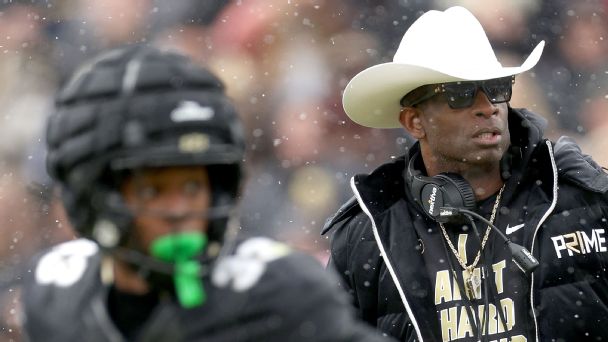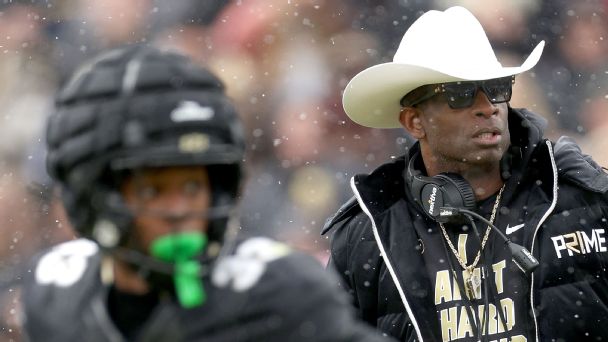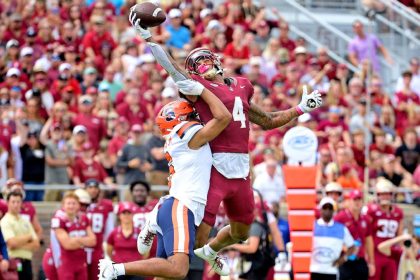
Give Colorado credit for one thing: While its football prowess has diminished dramatically in the 2000s, it remains one of college sports’ key realignment weather vanes. Wherever the winds are blowing, that’s where you’ll find the Buffaloes.
Thirteen years ago, Colorado got an invitation to leave behind the dramatic uncertainty of the Big 12 for what felt like an exciting, up-and-coming Pac-12, a conference with huge plans and a big-dreaming commissioner in Larry Scott.
Last week, the school did the same thing in reverse, running from a Pac-12 that had lost two members and hadn’t yet been able to secure an elusive, new media rights deal. Back to the Big 12 the Buffs will go in 2024, wooed by an ambitious and bold commissioner in Brett Yormark.
Scott’s big dreams obviously didn’t come to fruition out West. While it seemed likely he would land Texas, Oklahoma and half the Big 12 for a few days in spring 2010, the move fell apart due to some combination of conservative Pac-12 presidents and Texas’ cold feet. And thanks to pure geography, there were no more home run swings to attempt after that. Scott made a number of ill-advised decisions in setting up (and failing to get proper distribution for) the Pac-12 Network, and the conference went from aspiring powerhouse to stuck in the mud.
Two years ago, it seemed the Pac-12 had another shot at a Big 12 knockout blow. The Big 12 found out it was losing Oklahoma and Texas to the SEC, and the Pac-12 seemed to have an opportunity to land some of the Big 12’s remaining Texas schools. But new commish George Kliavkoff couldn’t get those stodgy presidents aligned, and the moment passed. The Big 12 added four sturdy football brands, hired a new commish and here we are.
Kliavkoff has yet to really score a win of any kind, and after months of teasing out a media rights deal that has never come to fruition, the Pac-12 is for the moment a Pac-9, with Yormark aiming to steal at least one more program. This is the most vulnerable a power conference had been since, well, the last time Colorado changed conferences. Let’s take stock as we wait for the next shoe to drop.

The Big 12 survived Colorado’s departure
It’s worth a reminder, right? When Colorado announced it was leaving for what would become the Pac-12, it was another in a series of blows for the Big 12 that would eventually see Nebraska exit for the Big Ten and Texas A&M and Missouri depart for the SEC. As with the current Pac-12, it seemed as if the Big 12 was not long for this world. But rule No. 1 in conference realignment is, simply, survive until tomorrow. Do that enough and the tables might turn in your favor.
The Big 12 eventually added TCU, the best mid-major program in its footprint, and a restless West Virginia from the Big East. That bought time. In 2022, TCU scored the conference’s first College Football Playoff victory, knocking off Michigan to reach the national title game.
The Pac-12 can still survive too. As ESPN’s Pete Thamel wrote about Colorado’s departure, “The biggest damage here so far is perception.” For now.
The perception is pretty awful, though. Kliavkoff has now overseen the loss of one-quarter of conference membership. Scott left him a poor hand, one always complicated further by geography and the fact that you can’t get some of the conference’s university leadership to agree to anything particularly useful or proactive. Kliavkoff seemed to spend most of his early tenure bending over backward to make USC happy, but he still had no card to play when USC and UCLA got the itch to leave for more money.
Plus, Kliavkoff was extraordinarily naive in his belief in the Alliance — an idea that seemed pointless in real time and downright foolish after the Big Ten, an Alliance mate, stole his marquee programs — and he was dramatically outmaneuvered by Yormark in terms of securing future media rights.
Losing Colorado is maybe the single biggest unforced error in 21st-century conference realignment. (The second biggest might be the Pac-12 failing to add any of the Big 12’s schools two years ago.) We don’t yet know, however, if this is actually a costly error. It doesn’t have to be.
Frankly, replacing Colorado in the football department will be easy. Granting the excitement of Deion Sanders’ head-coaching tenure there, the Buffaloes have still been a disaster on the field for most of the 2000s.
Over the past 10 years, Colorado’s average SP+ ranking is a dismal 82.9, lower than potential expansion candidates Boise State (41.2), San Diego State (57.0) and SMU (80.7), not to mention three other Mountain West programs in Air Force (63.8), Utah State (73.9) and Fresno State (74.4). Hell, Tulsa (86.3), Colorado State (88.0), UTSA (88.4) and Wyoming (89.3) have basically been Colorado’s equals, and North Dakota State and South Dakota State have been Colorado’s superiors despite living in the Football Championship Subdivision. If Yormark manages to snare, say, Arizona, as well, that’s also manageable; the Wildcats have averaged an SP+ ranking of 86.0 since 2016.
The biggest problem at hand is a pure numbers issue. If Arizona were to leave, that would drop Pac- 12 membership to eight. If the other so-called Four Corners schools — Arizona State and Utah — panic and leave too, the conference would be down to six. The league’s former North Division would be all that’s left, and there’s a threshold past which even Oregon or Washington, the conference’s biggest remaining brands, would start gazing longingly at the Big 12, even if that means patently ridiculous future conference games at West Virginia and UCF (and UConn?).
Kliavkoff has failed on every primary goal to date, but there’s really only one goal that matters at this point: keeping Oregon and Washington. If the Big Ten comes after them, there’s nothing you can do. But that doesn’t appear to be in the short-term cards, and you can’t lose them to the Big 12.
What the Big 12 is actually getting
In March 1947, Colorado announced it was leaving the Mountain States Athletic Conference (often referred to as the Big Seven) for the more ambitious confines of the Big Six. After dabbling with a rebrand as the Midwest Conference, the Big Six became the Big Seven, as the original Big Seven became the Skyline Six. Keeping up? There will be a pop quiz later.
(We make fun of conferences keeping incorrect numbers in their titles — the 16-team Big Ten, the now-13-team Big 12 — but hey, it’s better than whiplash name changes, isn’t it?)
In response to Colorado ditching BYU, Colorado State, Denver, Utah, Utah State and Wyoming for Iowa, Kansas, Kansas State, Missouri, Nebraska and Oklahoma, John Mooney, sports editor of the Salt Lake Telegram, wrote, “Colorado university’s decision Saturday to desert the boys’ department (Big Seven) in favor of the young men’s department (Big Six) in the nation’s athletic department store may not be too much of a loss at that, because the credit of the Golden Buffaloes wasn’t too hot, a spokesman for the Big Seven said.” They had a way with words back in the 1940s.
Aside from a run in the 1980s and 1990s, Colorado’s credit indeed remains dicey.
In eight seasons from 1989 to 1996, first under Bill McCartney then under Rick Neuheisel, the Buffaloes ripped off five AP top-10 finishes along with a shared national title in 1990; in the other 79 years of the poll era, they’ve finished in the top 10 three times. They have finished the season ranked just once since 2003, and they have finished above .500 just twice since 2005. In 2016, they won the Pac-12 South with an inspiring 10-2 regular-season run but finished the season with losses by a combined 79-18 to Washington and former/future conference mate Oklahoma State. In the abbreviated 2020 pandemic season, the Buffs won their first four games by a combined 30 points then lost their last two by a combined 49.
For as challenging as Colorado’s Pac-12 stint has been — CU has gone 47-94 overall — things wouldn’t have been any better among its future Big 12 brethren. Using SP+, here’s where the Buffaloes would have ranked among the 13 teams that will make up the Big 12 starting next season.
2011: 98th nationally, 13th in the future Big 12
2012: 115th nationally, 13th in the Big 12
2013: 81st nationally, 12th in the Big 12
2014: 81st nationally, 11th in the Big 12
2015: 79th nationally, 11th in the Big 12
2016: 36th nationally, sixth in the Big 12
2017: 60th nationally, ninth in the Big 12
2018: 77th nationally, 12th in the Big 12
2019: 83rd nationally, 12th in the Big 12
2020: 82nd nationally, 12th in the Big 12
2021: 88th nationally, 12th in the Big 12
2022: 126th nationally, 13th in the Big 12
That’s one year in the top half of the conference and 10 in the bottom three. Pretty dire stuff.
Granted, football isn’t the only sport that matters, from either a revenue or general status perspective. Colorado did make four NCAA tournament appearances in five years from 2012 to 2016 in men’s basketball, and the Buffaloes were a 5-seed in 2021, pounding Georgetown before losing to Florida State. In women’s hoops, the Buffs are on the uptick: They’ve been to the NCAA tournament just three times since 2004, but they have gone in each of the past two years, and they upset Duke on their way to the Sweet 16 in 2023.
CU finished 61st in this year’s Learfield Directors’ Cup rankings — a points-based competition that takes into account all NCAA sports. Granted, that ranked 11th in among Pac-12 programs (which tend to rank quite well because of success in many non-revenue sports), but it’s a decent seventh among its future Big 12 mates. It will certainly raise the Big 12’s stature in sports like cross country and skiing and, at worst, won’t be an albatross to the conference’s elite men’s basketball stature. And hey, Boulder might be the best college town in the country not named Madison. It’s gorgeous.
Maybe Yormark has made that beautiful drive from Denver to Boulder at some point, and maybe it inspired him. Maybe he has strolled down Pearl Street at some point or maybe he has taken in a game at Folsom Field. If that left an impression, I can’t blame him.
More likely, Yormark was aiming for two things with this move: Larry Scott-style disruption and Deion Sanders. Yormark has presented himself as the most aggressive and ambitious major-conference commissioner since Scott. Yormark seems to be banking on this move creating panic among other current Pac-12 (and future Big 12?) members, and he seems to be taken by the potential Sanders brings to the table.
Colorado has certainly been the team of the 2023 offseason. Sanders unapologetically pushed most of the members of last year’s dreadful team out the door, and he will pit an almost entirely new roster — more talented but probably still quite thin — against a brutal schedule in his first season in charge. He has thus far been as much of a headline grabber as a coach, similar to how he was when he played the game himself. And for as long as he’s at CU, the Buffaloes likely will be in the news.
But how long will that be? And how many games will he eventually win when he isn’t compiling the sort of dramatic talent advantage he was able to put together at Jackson State? If the rest of the members of the Pac-12 hold steady — far from a given — and Yormark ends up with Colorado as the only Western addition, it’s hard to simply assume this is a great long-term move. There’s nothing wrong with breaking even, but it’s clear Yormark sees this as step one of a master plan. We’ll see how masterful it ends up.
The importance of auto bids
The Big Ten and SEC are the monsters on the hillside, the super heavyweights that will dominate college football even more than usual — from both revenue generation and performance standpoints — moving forward. There’s really no avoiding that at this point. But the conferences lower on the totem pole could still have a secret weapon moving forward, one that keeps them relevant: automatic bids.
In 2024, the College Football Playoff will expand to 12 teams, with six of the bids guaranteed to go to conference champions. There’s significance to that. To me, the most important piece of playoff expansion has always been inclusion; for the first time ever, every single college football program can start a season knowing that if it fields its best ever team and goes unbeaten, it will almost certainly get a spot in the national title race. As much as money might gravitate toward college football’s Big Two conferences, everyone else still has seats at the table. It’s a leveler of sorts: It assures that the rest of the Football Bowl Subdivision still matters in the broader picture, and it adds a ton of extra intrigue to what is already a rather frantic conference championship weekend.
We’re only guaranteed those auto bids for two years, however. Heading into 2026, everything — the TV contracts, the format and so on — will be up for renegotiation. If the SEC and/or Big Ten were to throw their weight around in a chance to score more bids for themselves, maybe they would be able to lop off a few of those bids.
In a future with six auto bids, winning the Pac-12 will still matter a lot within the national picture, even if its stature is diminished by departures. (Considering a Pac-12 team hasn’t made the four-team CFP since 2016, it would matter even more than it has of late.) Without the auto bids, however, both the future relevance and plain old future of these conferences get a little dicier.
The undead
In the end, 2010s conference realignment couldn’t even kill the WAC. It was only mostly dead.
Home to a lot of the schools Colorado had ditched after World War II, the Western Athletic Conference formed in the early-1960s, first with Arizona, Arizona State, BYU, New Mexico, Utah and Wyoming. It picked up stragglers along the way — Colorado State and UTEP in the late-1960s then San Diego State, Hawai’i and Air Force in the late-1970s, after the Arizona schools had left for the Pac-10. The WAC began to thrive as a way station for weird, wild football: BYU won a national title in 1984 while passing far more than anyone else would think to; Air Force knocked out three AP top-15 finishes by running the triple option in the 1980s and 1990s; and SDSU, UTEP and Wyoming were all pass-happy and innovative at one point or another. It had damn near earned power conference status in the 1990s, but it turned out to be a little too far ahead of its time.
In 1996, in the wake of the Southwest Conference’s half-dissolution and half-merger with the Big 8, the SWC’s leftover programs joined what became a 16-team WAC. Cultural differences within the conference, plus the simple fact that the world wasn’t ready for a 16-team super(ish) conference spanning from Hawaii to Houston to Laramie in the 1990s, led to its demise. The conference’s better programs (including all of its remaining founders) had broken off to form the Mountain West by 1999. And by 2012, in the ripples of the realignment push that had almost seen the Big 12 devoured, what was then a seven-team WAC officially got picked apart: Utah State and San Jose State went to the Mountain West; Louisiana Tech and UTSA went to Conference USA; Texas State went to the Sun Belt; and Idaho and New Mexico State were left as independents. (Idaho eventually dropped down to FCS, while NMSU just rejoined LA Tech in C-USA.)
The WAC didn’t die, though. It continued sponsoring other sports with a random roster of willing FCS-level programs; and in 2021, it announced that it would be sponsoring football again with schools like Abilene Christian and Stephen F. Austin aboard. In recent months, in conjunction with the Atlantic Sun, the WAC has been attempting to finagle its way back into the FBS ranks. How delightful it would be to get the conference back.
Perhaps this ends up being an instructional example when it comes to pondering the future of the Pac-12. Or perhaps this is where our story takes on more darkness and finality.
Colorado leaving the Pac-12 for the Big 12 is not the summer blockbuster to which we’ve grown accustomed. It’s not Oklahoma and Texas leaving for the SEC (2021) or USC and UCLA to the Big Ten (2022). There’s a chance that merely small ripples emanate from this; the conference hierarchy being what it is, there are still plenty of intriguing and exciting schools that would say yes to a Pac-12 invitation in a heartbeat if school presidents are able to suck it up and actually make a proactive decision or two. Hell, an NCAA tournament finalist tried saying yes before it even had a genuine invitation! There is indeed still a hierarchy here, and being in the Pac-12 still represents an aspiration for many schools.
The next few days and weeks are key, though. You can survive losing Colorado, and you can probably survive losing Arizona, but there’s a limit, and we won’t know it until we see it. Even if the WAC was technically unsinkable, it did still lose its founding members then almost everyone for a while there. Missteps can still be very costly, and the Pac-12 has made nothing but missteps over the past couple of years.











